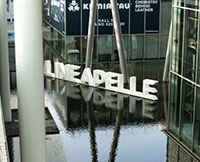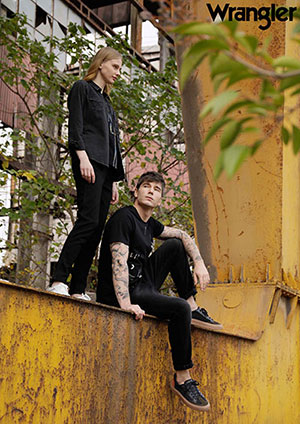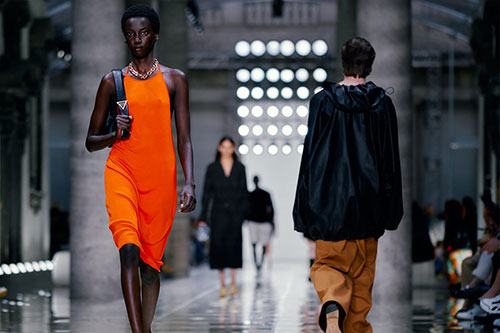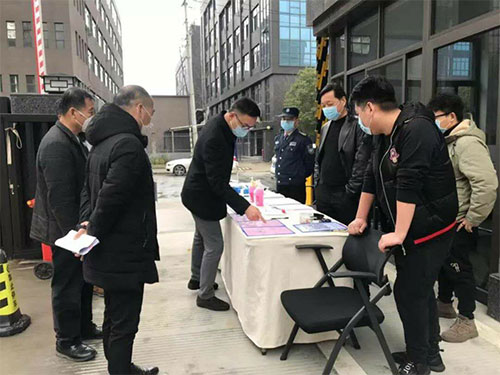FW
 Lineapelle closes the 98th edition, going beyond the current global forecasts and emergencies, concretely strengthening its international leadership.
Lineapelle closes the 98th edition, going beyond the current global forecasts and emergencies, concretely strengthening its international leadership.
Held at Fieramilano Rho from 19 to 21 February 2020, Lineapelle confirms its importance for the global supply chain in the fashion and luxury goods sector by welcoming almost 20,000 visitors, an increase of 2% compared to the 2019 edition. A growth evidenced by both Italian and foreign operators despite the absence of Chinese and Far Eastern exhibitors and buyers due to the coronavirus epidemic.
In addition to the positive attendance, the exhibitors at Lineapelle also reported the excellent level of quality of the visitors, the result of the synergy with footwear, Micam, and leather goods, Mipel, with whom Lineapelle shared a day of exhibition, Wednesday, February 19. While Lineapelle is archiving the edition dedicated to the summer season 2021, the exhibition Questione di Pelle organized by Lineapelle and curated by journalist Mariella Milani, under the artistic direction of Simone Guidarelli, will be open until Saturday 29th February at Spazio Lineapelle in Palazzo Gorani in Milan.
the visitors, the result of the synergy with footwear, Micam, and leather goods, Mipel, with whom Lineapelle shared a day of exhibition, Wednesday, February 19. While Lineapelle is archiving the edition dedicated to the summer season 2021, the exhibition Questione di Pelle organized by Lineapelle and curated by journalist Mariella Milani, under the artistic direction of Simone Guidarelli, will be open until Saturday 29th February at Spazio Lineapelle in Palazzo Gorani in Milan.
Questione di Pelle is an exhibition project that celebrates leather and describes its beauty and versatility through some creations by Gianfranco Ferré (provided by the Gianfranco Ferré Foundation) and garments by designers Bozart, Cecilio Castrillo, Alessandro Dell'Acqua, Mario Dice, Diego Dolcini, Ely.B, Massimiliano Giornetti, Simone Guidarelli, Mani del Sud, Antonio Marras, Italo Marseglia, Simone Marulli, Sermoneta, Ventaglidautore, Vivetta, Alessandra Zanaria.
The next edition of Lineapelle will take place at Fieramilano Rho from 23 to 25 September 2020 and will be dedicated to the autumn/winter 2021/2022 season.
 This season, Wrangler introduces their fresh outlook on tees and shirts featuring asymmetrical designs, HD prints, reflective prints and accentuated blurred print styles. The men’s denim range stars reflective elements and pocket detailing. The Monochrome collection plays with blacks, greys and whites and it adds an edge to your wardrobe. This range is exclusively designed to make a statement in the day or light up the night.
This season, Wrangler introduces their fresh outlook on tees and shirts featuring asymmetrical designs, HD prints, reflective prints and accentuated blurred print styles. The men’s denim range stars reflective elements and pocket detailing. The Monochrome collection plays with blacks, greys and whites and it adds an edge to your wardrobe. This range is exclusively designed to make a statement in the day or light up the night.
The all new Monochrome collection from Wrangler brings forth the hi-style, uber cool range inspired by the futuristic design elements.
The heritage of Wrangler goes back 70 years, when the brand was launched in the U.S.A. Wrangler was the first modern five-pocket jeans to be test-fitted and endorsed by real-life cowboys. Since then, Wrangler continues to inspire freedom, independence and adventure in its wearers.
In India, the brand has evolved to meet the needs of the ‘urban cowboy’ with a range of fashion apparel that is contemporary and fashionable yet rugged.
Wrangler has found a loyal consumer base in the Indian youth that swear by this unique fashion brand. This stylish denim brand is available at exclusive Wrangler stores, major department stores, leading apparel stores and popular e-commerce websites.
Pakistan’s raw cotton imports increased 42 per cent in fiscal July to January as compared to the same period last year. In January 2020, Pakistan’s raw cotton imports surged 51.2 per cent as compared to January 2019. The country’s trade deficit shrank by 28.4 per cent in the first seven months of fiscal ’20. Total textile imports including raw cotton, synthetic fiber, synthetic and artificial silk yarn, worn clothing and other textile items rose 32 per cent in January 2020 as compared to January 2019.
Pakistan is trying to increase its textile exports. Presently, its share is 1.6 per cent in the world textile trade. Efforts are on to increase this to three per cent by 2025. The potential of home-grown cotton will be fully utilized augmented by manmade fiber/filament to boost value-added exports and become a major player in the global textile supply chain. Among the objectives are restoring the profitability of cotton farmers by increasing cotton yields, improving the quality of cotton and decreasing the cost of production for farmers, strengthening the manmade fiber/filament sector to make this chain internationally competitive and export oriented, long-term financing facility for the entire textile value chain, revival of impaired textile capacity and establishment of textile clusters and export processing zones with plug and play facilities.
Decathlon ended 2019 with a revenue growth of nine per cent. Decathlon’s revenues in France, its main market, rose three per cent. The French sporting goods retailer is present in 69 countries around the world, nine more than a year ago, after sealing its entry into markets such as the United States, Algeria, Vietnam, Malta, Japan, South Korea and Ukraine. The number of employees has grown from 87,000 to 93,000 workers. Decathlon has invested in store openings and corporate operations.
The target for the sportswear and goods retailer is to reduce carbon dioxide emissions per product sold by 40 per cent between 2016 and 2026 for all its sports categories. Decathlon wants to achieve these targets by a number of sustainable strategies, including using 100 per cent renewable electricity by 2026 in its stores – including its 45 in the UK – and warehouses. In addition, 100 per cent of Decathlon’s new products will be eco-designed by 2021 and the retailer will also investigate into developing the sale of secondhand products throughout the store. Decathlon is also striving towards using just one per cent air freight for its transportation needs and reducing the impact of other means of transport, such as through maritime or road.
Chinese silk is popular in India but the Coronavirus has put a strain on imports. Indian fabric wholesalers are looking for alternatives as the wedding season is about to begin. Silk imported from China is widely used to make Indian traditional wear. Chinese textiles are in demand due to their quality and price, which is often cheaper than domestically produced alternatives.
Given that there are travel restrictions, many traders who used to supply fabrics to retail stores and fashion designers can’t visit their suppliers in China. Other textiles imported in large quantities from China to India include tulle, chiffon, net, crepe, and georgette, textiles used in large quantities for summer occasion wear.
India’s silk imports have fallen drastically over the last four years. The country hopes to reduce its dependence on China for the import of high quality silk and become self-sufficient in silk production by 2022. The decrease in import volumes has been primarily on the back of an increase in production of bivoltine silk. While the total production of raw silk has recorded an annual growth rate of around five per cent, that of bivoltine silk which is superior quality silk has grown by 13 per cent.
Canopy is supporting the promotion of rayon and viscose products made from low-impact alternative fibers such as textile waste, microbial cellulose and agriculture residues.
Between 70 to 100 million trees are logged annually to produce pulp for rayon, viscose, modal and other cellulosic fibers. With demand for dissolving pulp projected to increase 122 per cent in the next 40 years, the cellulosic fiber industry poses a growing threat to vulnerable forest ecosystems.
Technology, however, could help. With viscose mills rallying to support new inputs, next-generation feed stocks could replace at least 90 per cent of viscose production volumes coming from ancient and endangered forests by the end of 2025. By 2030, as much as 50 per cent of all viscose could be made from next-generation feedstocks. Of the world’s five largest viscose producers, three already offer initial product lines with 20 per cent to 50 per cent recycled cotton. With an estimated 26 million metric tons of waste cotton and viscose textiles landfilled every year, a fraction of that could be mined to produce the 6.5 million metric tons of viscose currently generated annually.
The industry is moving away from viscose containing ancient and endangered forests and is ready for new innovative viscose fiber sources.
Ministry of Textiles under the dynamic leadership of Hon’ble Union Textile Minister, Smt. Smriti Zubin Irani, is in the process of formulating the new textile policy and it is likely to be announced in 2020. The Ministry has been conducting series of meetings for each segment and is in the process of drafting the Policy with the objective of making Indian textile industry a true global leader by improving its competitiveness, bridging the technology gap, encouraging sustainability and creating global brands for Indian textiles and clothing products. In this endeavor, the Ministry has started a bold initiative of mitigating the major challenge of scale of operation through the proposed mega textile park. In this connection, Secretary (Textiles), Shri Ravi Capoor convened a meeting with the industry stakeholders and the senior officials of various State governments on 17.2.2020 and gathered necessary inputs to frame the scheme.
Mr. T. Rajkumar, Chairman, Confederation of Indian Textile Industry (CITI) has appreciated the unique initiative of encouraging scale of operation through the mega textile park scheme. Mr. Rajkumar has stated that the flagship programme of TUF Scheme had attracted over Rs. 4 lakh crores during the last two decades, the Scheme for Integrated Textile Parks, enabled the powerloom sector and few other decentralized sectors to consolidate in different clusters and go for modern technology. In addition to few large players also could take advantage of SITP.
CITI chief has said that the country has been suffering with scale of operation and the new entrants like Bangladesh, Vietnam, etc., could grab the space vacated by China due to scale of operation and cost competitiveness. He said that at the global brands meeting chaired by the Hon’ble Union Textile Minister, most of the brands having retails in India, had stated that they had to import from countries like China, Bangladesh and Sri Lanka due to volume and cost advantage. They also stated that India does not have large players to meet their demands.
Mr. Rajkumar has stated that the Central Government is making efforts to attract FDI, joint venture projects and also encourage large vertically integrated textile giants in the country to make investments in the proposed mega textile parks by setting up of a large scale vertically integrated textile manufacturing units. He said that the Government is contemplating to extend maximum support for the infrastructure facilities including land by the state governments, water, power, road connectivity, special priority in the port, relaxation in labour laws, etc., and the government is planning to market the scheme in different countries to attract FDI and joint venture projects jointly with the state Governments. Mr. T. Rajkumar has said that the proposed mega textile park scheme would throw more opportunities for the textile industry to cater to domestic markets and also international market.
Stitch & Tex Expo-Afro Edition, distinguished as “Africa’s Premiere Sourcing Trade Fair for Textile Technologies”; is featuring the presence of over 1000 brands from 37 countries namely: Australia, Austria, Belgium, Brazil, Bulgaria, Canada, China, Czech Republic, Denmark, Egypt, Finland, France, Germany, Greece, Hong Kong, India, Italy, Japan, Korea, Malaysia, Malta, Netherlands, Poland, Portugal, Russia, Singapore, Slovenia, South Korea, Spain, Sweden, Switzerland, Taiwan, Turkey, UAE, UK, Ukraine, USA to serve over 40,000 visitors from Egypt and the entire African continent.
Stitch & Tex Expo- Afro Edition; will be held with the new concept of organizing two consecutive trade fairs; The first trade fair is dedicated to garment processing technologies including sewing, embroidery, fabrics and their accessories; While the second is dedicated to textile processing technologies including weaving, spinning, knitting, and dyeing machinery, technologies and spare parts; The two events are held under the giant brand Stitch & Tex Expo- Afro Edition; and will be held in the prestigious venue Cairo International Conventions and Exhibitions Center- Egypt during the period 27 February - 1 March 2020 and 5 -8 March 2020 consecutively.
Fortifying its continental leading position as Africa’s most important trade fair and platform for textile technologies, the Cairo International Convention Center will be shaped by the numerous investments, spontaneous business deals and lively discussions in addition to the exchanges of industrial expertise between exhibitors and professional visitors.
Held on an area exceeding 40,000 sqm; the exhibition covers the entire international market; where global old players, innovative newcomers and providers of niche technology are all represented here.
The 1000+ brands exhibiting will demonstrate progressive industrial solutions that will be revealed for the first time in the African markets to fuel the upward textile technologies demand; whilst exploring unprecedented profit-making business hot-spots.
For the first time in the history of textile technologies trade fairs in Africa, the event will feature the presence of 100 accredited buyers and factory owners from Ethiopia, Kenya, Lesotho, Mauritius, South Africa, Madagascar, Tanzania, Algeria, Morocco and Tunisia to hold open channels of communication directly with the exhibitors within a well set bilateral business meetings program.
Stitch & Tex Expo- Afro Edition will open its doors daily for the garment processing technologies edition visitors during the period 27 Feb- 1 March from 11:00 am till 8.30 pm, and will open its doors again for the textiles processing industry edition visitors during the period 5-8 March from 11:00 am till 8.30 pm.
"Stepping up their sustainability efforts, fashion players like Kering and LVMH are organising hackathons that include awarding prizes to developers, students and experts to help them manage their supply chains and overproduction. However, as these hackathons lack proper resources or metrics, they run the risk of turning into ideathons that though discuss many issues do not resolve any of them."
 Stepping up their sustainability efforts, fashion players like Kering and LVMH are organising hackathons that include awarding prizes to developers, students and experts to help them manage their supply chains and overproduction. However, as these hackathons lack proper resources or metrics, they run the risk of turning into ideathons that though discuss many issues do not resolve any of them.
Stepping up their sustainability efforts, fashion players like Kering and LVMH are organising hackathons that include awarding prizes to developers, students and experts to help them manage their supply chains and overproduction. However, as these hackathons lack proper resources or metrics, they run the risk of turning into ideathons that though discuss many issues do not resolve any of them.
One such hackathon was organised by luxury brand retailer Kering in October 2019 in Paris. This hackathon gathered 80 tech developers, students and industry experts at the behest of the brand’s chief sustainability officer Marie-Claire aveu to participate in ‘ Hack to Act’. The sun-soaked L’Atelier Riechelieu went on for 48 hours as competitors vigorously prototyped updates to My EP&L, an app Kering launched in 2017 that uses data from the French luxury group’s Environmental Profit & Loss research to educate designers and students on sustainable design principles.
Hackathons becoming more targeted
Hackathons enable brands to think and operate like tech companies. Once reserved for intensive digital prototyping by coders and software engineers, these hackathons are now becoming more targeted. Besides Kering, LVMH, Prada and German online retailer Zalando have held hackathons based on sustainability, as pressure surrounding the environmental impact of luxury fashion mounts.
prototyping by coders and software engineers, these hackathons are now becoming more targeted. Besides Kering, LVMH, Prada and German online retailer Zalando have held hackathons based on sustainability, as pressure surrounding the environmental impact of luxury fashion mounts.
The challenge for these brands lies in whether the proposed solutions generated by these hackathons are practical enough to be implemented in the real world and whether they would have a measurable positive impact on the environment.
Helping brands reduce footprint
One of the reasons, fashion companies are turning to hackathons is to reduce their carbon footprint. Hackathons also enable these companies to advertise their sustainability initiatives. Held in July 2019, Moncler’s hackathon listed sustainability as one of the problem areas to be addressed, while LVMH’s hackathons bring together employees from across sectors, disciplines and continents in order to identify talent and new innovations for their hackathons.
Some of LVMH’s successful hackathons have yielded projects including zero-waste packaging for its wine and spirits category, and the implementation of a process that turns grape seed waste from its wine portfolio into a cosmetics ingredient. Despite these activities, experts wonder if hackathons are becoming more of a marketing ploy rather than a function for change. As Liz Bacelar, Co-founder, The Current Global points out, many events that brands call ‘hackathons’ are really ‘ideathons.’ She defines hackathons as something that results in a working product and go-to market strategy. In order to be successful, sustainability hackathons need to be backed by research, to identify challenges and to include industry mentors in fashion and R&D to guide young entrepreneurs. Else, brands run the risk of concluding with a handful of silver-bullet ideas unlikely to be realised.
Jan Leyssens, Co-founder of social good agency Switchrs defines hackathons as something that though bring new ideas or concepts to life, don’t magically translate these into real products or new businesses. The brand has facilitated several hackathons in multiple sectors, including one at a fashion festival in 2018 in Antwerp called MOOI.
One of the highest points for hackathon awards was the €10,000 prize announced by Kering. LVMH also offered €5,000 to winners of a student hackathon it sponsored around beauty products. However, other brands have only paid for travel expenses, offered mentorship and networking opportunities, or given out gifts to participants. This is rather demotivating as compared to the €50,000 cash prize announced for the designer or startup who wins the Yoox and Vogue Italia sustainable innovation competition or the €150,000 total prize money offered to winners of a sustainable fashion contest by the European Commission. However, these competitions will reward innovations introduced over a span of a year instead of just 48 hours.
Survey Shows Coronavirus Impact on Chinese Textile Industry -Part III
While businesses have restarted on limited basis, the impact on the companies in the survey in the first half of the year is not ambiguous if we just see some of the important indicators like business income, profits, employment and export.
A national online survey was conducted by China National Textile and Apparel Council (CNTAC) from February 7-10, with a report circulated only to limited readership to show a comprehensive outlook and insight of the textile industry by specific sectors in different provinces on the basis of 1201 respondents, just a sample of the whole textile economic fabric if we can see wood and see forest. Continuing here is Part III of the survey analysis, as estimated impact on Chinese business for the first half of 2020.
Impact on Employment
Employees being the valuable assets even though the progress of modernization and digitalization driven by AI technology is cannibalizing human jobs. 9.5% of the companies in question think that there is no impact on their employment, but there is a bulk share of the companies, who have difficulty in recalling back their workers during this time of coronavirus , as is manifested by the 21.9% of the respondents reporting over 30% laborer loss and 44.1% of the companies with reduced employment by 10%-30%, and 24.5% of the survey participants expected to have less than 10 percent loss of their operators as compared with the same period last year.

In the segmental view, we see more loss of workers in garment, knitting and base textile sectors, rating at 31.6%, 30.9% and 30% respectively. Obviously, smaller companies have less employs and expected to be more handicapped.
Estimated Impact on Employment in the Companies in the First Half of the Year

Impact on Business Income
The first half of the year will see a reduced income by more than 20% in 65.2% of the companies surveyed, and by 10%-20% in 24.5% of the respondents under survey, as businesses are hard to rehabilitate to the full potential with uncertainties still struggling with doubts whether to take more orders while workers are not yet available in full number or to wait with inadequate capacity kept running until the situation turns out to be better.
Estimated Reduction of Business Income for the First Half

Impact on Export Estimation
China’s export from textile industry constitutes around 36 percent of the global outbound shipments in this trade sector, regardless of its increased investment in overseas operations in low-income countries largely in Southeast Asia, Africa etc. The increase in labor cost might be one of the important drivers for outgoing investments, resulting in year-on-year decrease of the textile and apparel export that registered US$280.7 billion last year with a slight drop at 1.5%, but significantly 5.3 percentage points down as against the year before. In spite of the export slowdown, it is still an important pillar that supports the whole textile economy. The impact as induced by the coronavirus on the export business is much of a growing worry if the indicator continues to remain as it chalks down in the survey.
83.6% of the knitting companies, 75% of the silk textile manufacturers, 73.7% of the base textile mills and 72.5% of wool textile enterprises responded to say that they would fall by over 10 percent in export as opposed to the first half of last year. 54% of all the companies in the survey report said that they would meet over 10% down in their export business, some silk companies in particular, reported to say their shipping out business would be cut by half, consequently.
Impact on Export for the First Half of 2020 (estimated)


The article is provided with data taken from the analysis report on the basis of online nation-wide Questionnaires survey with 1201 respondents. The impact on the textile industry is given in three phases as stated previously to cover the period from the start of New Year to the middle of February, and the period all the way down to the end of the month, and the longer period for the first half of this year. The picture looks a bit gloomy as the survey report came out on February 13, amid rising cases of symptoms suspected or confirmed for the novel coronavirus, to which people are susceptible if company owners waywardly summon workers back to work. The whole situation starts to look pretty sunny as the new symptomatic cases of the disease continue to drop over 16 days across the country. More and more people take on journey back to job on meticulously-arranged basis, business will return to not where we are, but to where we aim higher. Out of the distress of dark tunnel, we walk into the hope of sunshine.
Contributed by Mr. ZHAO Hong
He is working for CHINA TEXTILE magazine as Editor-in-Chief in addition to being involved in a plethora of activities for the textile industry. He has worked for the Engineering Institute of Ministry of Textile Industry, and for China National Textile Council and continues to serve the industry in the capacity of Deputy Director of China Textile International Exchange Centre, V. President of China Knitting Industry Association, V. President of China Textile Magazine and its Editor-in-Chief for the English Version, Deputy Director of News Centre of China National Textile and Apparel Council (CNTAC), Deputy Director of International Trade Office, CNTAC, Deputy Director of China Textile Economic Research Centre. He was also elected once ACT Chair of Private Sector Consulting Committee of International Textile and Clothing Bureau (ITCB)












